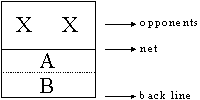
This document was prepared for the O.B.A. by Mr. John Gilbert, Level III Coach
Note that no differentiation is made between
men's and ladies' doubles. In both games the same basic
principles apply.
Doubles in badminton can be the most exciting game
of all if played well by both teams involved. Often, however, it
degenerates into two players monopolizing the play under the
impression they are brilliantly exploiting their own strengths
and covering their partners' obvious inadequacies. A team has
strengths and a team has weaknesses, but a team is composed of
two players interacting together. It is not composed of one
player with an animated handicap. Therefore, a team's selection
of strokes and strategies should not be haphazard at any level of
play. Doubles -- whether men's or ladies' -- must be discussed
under five headings:
I (a) Service and (b) Reception of Service
II Offensive Zone and Play
III Defensive Zone and Play
IV Movement from Offence to Defence
V Movement from Defence to Offence
Let us look at these in order.
Although the Level I Coaching Program does not
require a knowledge of the "flick" serve -- i.e. a
service which begins identically to the short service and then
goes deep in the court because of a sudden "explosion"
of the wrist -- all doubles players find this variation of serve
essential. At any time in badminton, on any stroke, you must have
at least some alternative stroke or your opponent will always be
in the right place at the right time. Therefore, when serving,
develop the ability to (1) short serve close to the top of the
net and landing just at the junction of your opponent's front
service line and centre line, (2) flick serve to the back of your
opponent's court. If these two serves are made to look as similar
as possible up to the point of contact and if they are carefully
mixed, you will do well. In better levels of play the short
service is used much more frequently.
If your opponent does not disguise the service,
lay in wait and ambush it. Remember, your opponent can not score
points if you kill the serve instantly whenever it appears.
However, if your opponent does disguise the service your work is
cut out for you. Try to penetrate the disguise: often there is
some little difference which a keen eyed observer can spot. Be
that person, or hire a coach to do it for you. If your opponent
serves long, smash it. If your opponent serves short, try to hit
to one of the following spots:
Obviously, if your opponents have major weaknesses,
they should be exploited. Return number one expects you to
get to the net fairly quickly. The second and third
returns would like you there quickly but will allow you to be a
little slower. How far from the net down the alley you hit the
bird depends on your opponents' offensive and defensive zones.
When a team goes on offence in badminton it
divides the court to maximize offensive power. The best division
yet developed is the

The court division for the defensive zone in
badminton is almost a complete opposite. In this case the players
adopt a "side by side" stance using the centre line as
their dividing line:

The next problem to consider is how a team moves
smoothly from offence to defence. For this, let us return to the
discussion on service and return of service. When service is
about to be delivered, both teams take up offensive positions.
Obviously this situation will not last, as each team attempts to
force the other to lift the bird.
Situation #1
Let us assume that the team receiving service hits
the bird deep down their opponents' backhand alley. Remember the
principle of balance and counterbalance and you should visualize
the situation as follows:


The priciple involved here is the same but the
situation tend to be more complex and involve a great degree of
anticipation.
Situation #1
You are on defence with your opponents smashing. One
is smashed at you which you manage to return without setting up
the smash again. You must immediately assume the
"up" position for your team's offence. Speed is
important here, since any delay will allow your opponents to drop
return your shot, forcing your team to lob the bird up again
whereupon they resume their attack. Note that the player who
returns the net drop or flat shot takes the "up"
position.
Situation #2
You are on defence and your opponent, instead of
smashing, hits a flat clear which you smash or drive back. Since
the mechanics of the execution of this shot prevent you from
moving quickly to the "up" position, your partner
should take that position.
Situation #3
Identical to #2, except your opponent drops. If the
opposing "up" player does not cover the net carefully,
you may be able to "sneak" a hairpin net shot in. If
so, you remain in the "up" position you are now in.
Remember that doubles is team work, and try to
develop your play to complement one another. Many good doubles
teams are not overwhelming in any category except team work. Obey
the "ten commandments" and you will make a good team:
Good luck.